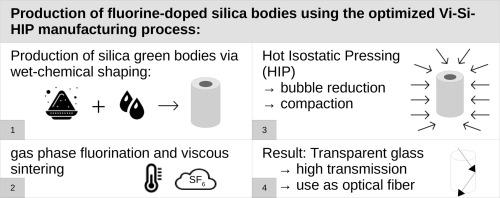采用优化的Vi-Si-HIP制造工艺,由粘性烧结和气相氟化相结合,随后进行热等静压,生产含氟硅体
IF 2.8
Q1 MATERIALS SCIENCE, CERAMICS
引用次数: 0
摘要
一种新的制造工艺旨在优化氟掺杂玻璃在能源效率方面的生产。绿体是由纳米级粉末在湿化学过程中产生的,并在含氟气氛中低温烧结。坯体成分和烧结参数,如气体气氛、温度和进料速度,对所得氟浓度和玻璃的形成有重要影响。随后的热等静压导致烧结体的完全压实和相关的传输增加。通过对样品进行再压缩,可以降低烧结温度,从而减少高烧结温度下的脱氟过程。本文章由计算机程序翻译,如有差异,请以英文原文为准。

Production of fluorine-doped silica bodies using the optimized Vi-Si-HIP manufacturing process from the combination of viscous sintering and gas phase fluorination with subsequent hot isostatic pressing
A new manufacturing process aims to optimize the production of fluorine-doped glass in terms of energy efficiency. The green bodies are produced from nanoscale powders in a wet-chemical process and sintered at low temperatures in a fluorine-containing atmosphere. The green body composition and the sintering parameters such as gas atmosphere, temperature and feed rate are important for the resulting fluorine concentration and glass formation. The subsequent hot isostatic pressing leads to complete compaction of the sintered bodies and the associated increased transmission. By recompressing the samples, the sintering temperature can be lowered, thereby reducing the defluorination process at high sintering temperatures.
求助全文
通过发布文献求助,成功后即可免费获取论文全文。
去求助
来源期刊

Open Ceramics
Materials Science-Materials Chemistry
CiteScore
4.20
自引率
0.00%
发文量
102
审稿时长
67 days
 求助内容:
求助内容: 应助结果提醒方式:
应助结果提醒方式:


